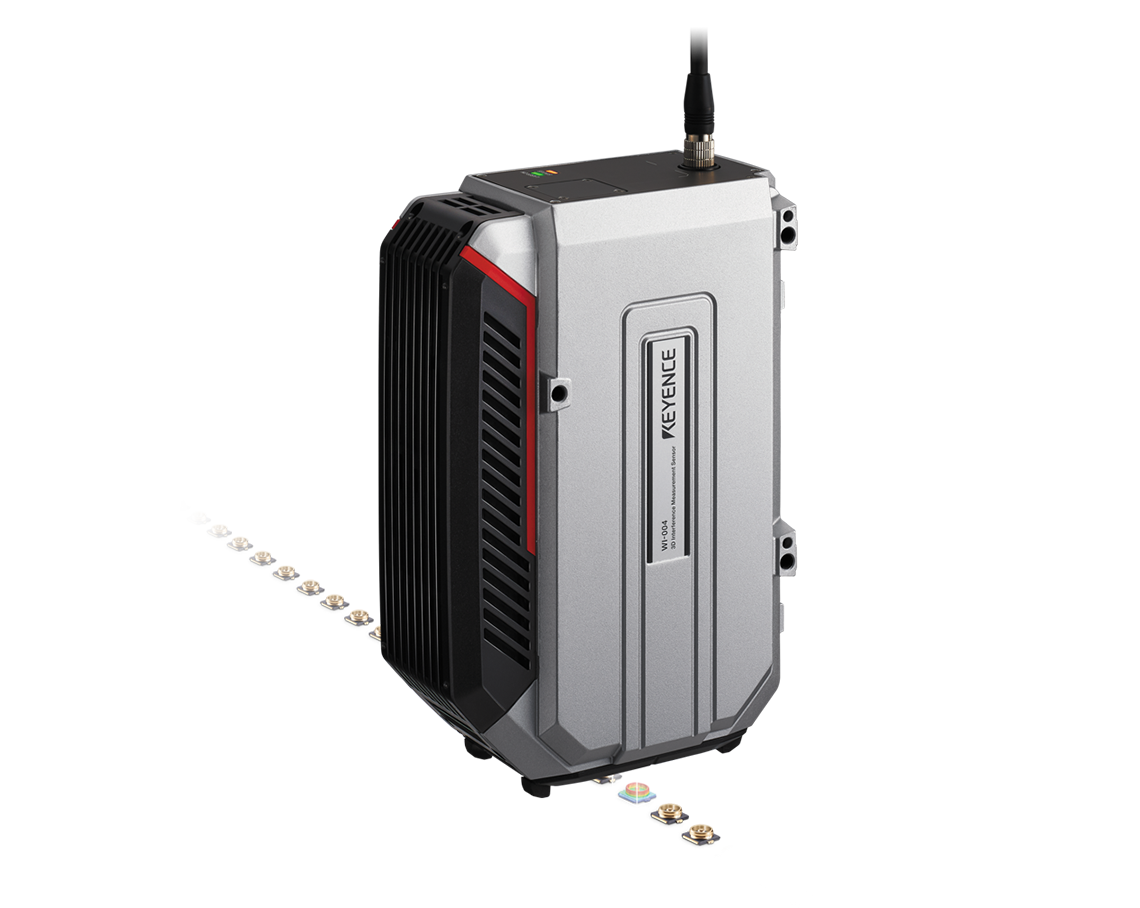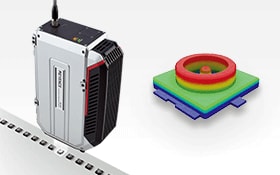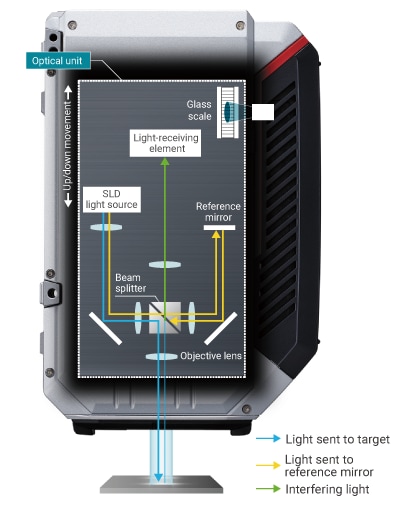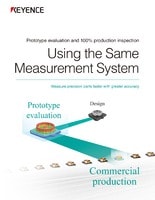3D Interference Measurement Sensor

Capturing images using 3D white light interferometry enables nearly instantaneous 3D measurement, perfect for use in production or offline inspection. Coaxial image capture eliminates dead zones and offers the best method for collecting 3D images from transparent or mirrored surfaces.
Lineup
The WI-5000 Series 3D interference measurement sensors capture a 3D image of target areas of up to 10 x 10 mm (0.39" × 0.39") in just 0.13 seconds. The sensor records 80,000 height data points across the surface simultaneously to perform high-accuracy measurement of height, coplanarity, and even surface roughness (Sa and Sz). By utilizing white light interferometry to capture images, the sensor can employ coaxial surface measurement, eliminating dead zones that prevent accurate measurement in grooves and other shapes with sharp height changes. The measurement principle enables accurate, repeatable 3D measurements on nearly any surface type, including transparent or mirrored targets. While its speed makes it ideal for inline measurements, an adjustable stand is also available, allowing users to capitalize on the same quick, automatic measurements for both inline and offline inspections.
Features

Area Measurement, Not Point or Line Measurement
Instantly measure 80000 points over a maximum measurement area of 10 × 10 mm 0.39" × 0.39". Utilizing the principles of white light interferometry, the WI-5000 Series is not affected by material type, color, or blind spots, allowing for high-accuracy, micron-level measurement.

100% Inline Measurement at High Speeds
In order to measure multiple points, the sensor must scan the target quickly and accurately. Doing so requires the stage to be moved, which makes inspection extremely time-consuming. With the WI-5000 Series, measurement is performed over a surface, significantly reducing measurement time and enabling 100% inspection.
3D interference measurement sensors emit light on the entire surface of the measurement area. They instantly calculate the height information of multiple points from the interference light received coaxially and with no blind spots while moving the optical unit up and down.
The principle of white light interferometry allows for high-speed, high-accuracy measurement of the 3D profiles, surface roughness, and line roughness of various targets such as transparent or mirrored targets, rough metal surfaces, and black rubber. These measurements are unaffected by the target’s material and color. Differing from measurements using 1D laser displacement sensors that use triangulation, the reflected light is not obstructed by surface features such as the ends of grooves and other such narrow locations because coaxial measurement is performed with the light from the surface. High-speed and stable measurement is possible because it is not affected by the profile of the target.
Explanations of the basic principle of white light interferometry as well as the mechanisms and measurement principle of KEYENCE’s WI-5000 Series 3D interference measurement sensors (which support inline 3D measurement) are given below.
Principle of white light interferometry
The interference of light is a phenomenon that occurs when there is a difference in the distance the light travels (the optical path) from the surface of the target to a certain point. With white light interferometry, one beam of light is emitted from the white light source and shines on the target while another beam of light is reflected by the reference mirror. The height or depth of the features on the target surface is then measured from the interference level of these beams.
3D interference measurement sensor mechanisms and measurement principle
This section uses a figure to provide a detailed explanation of the mechanisms and measurement principle of KEYENCE's WI-5000 Series 3D interference measurement sensors, which use white light interferometry to perform high-speed, high-accuracy inline measurements of targets with various materials, colors, and profiles.

3D interference measurement sensor mechanisms:
(1) Light is emitted from a broadband SLD light source that combines the characteristics of an LED and a semiconductor laser.
(2) The emitted light is split into two beams with the beam splitter in the optical unit.
(3) One of these beams shines on the surface of the target in the measurement area and is reflected. The other beam is reflected by the reference mirror in the optical unit.
(4) These two light beams enter the light receiving element as the interference light. The optical unit is moved up and down to change the length of the optical path of the light reflected from the target.
(5) At the light receiving element, interference light provides the largest interference level when their optical path lengths coincide with each other. Multiple contrast images are obtained, and the distance to the target (height or depth) is measured by reading the vertical position that gave the largest interference level for each pixel. The following explanation uses figures to clarify this mechanism.
Mechanism of Z-axis measurement via optical unit vertical movement:
The explanation of the mechanisms for optical unit vertical movement and for Z-axis (height and depth) data extraction follows the numbers in the figures.
(1) Light is applied to the surface of the target from the optical unit.
(2) Multiple contrast images are obtained while moving the optical unit up and down.
(3) The positions that result in the largest interference levels are determined, and the distance to the target is measured.
The peak interference level position changes depending on the target height, as shown in the figures. 3D measurement within the inspection region can be performed instantly and with high accuracy using this interference method. Measurements are calculated at high speed via concurrent processing of the height data for each of 80,000 pixels. This mechanism allows the WI-5000 Series to perform inline measurement of the 3D profile of the target, as well as surface roughness and line roughness.

a: Vertical movement of the optical unit b: Optical unit position c: Maximum interference level d: Interference level
Benefits of 3D Interference Measurement Sensors
Contact measuring equipment cannot be used with soft or easily damaged targets, since they apply pressure to the surface. 3D interference measurement sensors do not touch the target and can be used regardless of the material or color of the target, including transparent, mirrored, or black targets.
WI-5000 Series 3D interference measurement sensors do not touch the target, so they can even be used to measure soft synthetic rubber and easily damaged transparent glass. They can perform non-contact measurements of height, depth, and volume for targets that cannot be subjected to contact measurement, such as transparent sealants and adhesives in gel form and delicate electronic devices made of materials with varying reflectance. The entire target surface is captured, not just a point, so the speed and stability are far better than general measuring equipment. White light interferometry using a high-performance CMOS and an SLD light source with a wide dynamic range allows for one-shot measurement of the entire area as a batch. This image capturing is unaffected by target material or color, even for transparent or mirrored targets, targets that include black parts with low reflectance, or translucent resins that generate internal reflections.
With 1D laser displacement sensors that use triangulation, blind spots may occur where light cannot be received due to the reflected light being obstructed by indentations in narrow locations. 3D interference measurement sensors perform coaxial measurement of entire surfaces, so blind spots do not occur by the target’s profile.
With 1D laser displacement sensors that use triangulation, measurement may not be possible due to blind spots. Blind spots occur where the reflected light is obstructed by narrow indentations, which prevent the light from reaching the receiving end of the sensor. Furthermore, contact displacement sensors cannot measure indentations that are smaller than the contact area. WI-5000 Series 3D interference measurement sensors perform coaxial measurement of entire surfaces, so blind spots do not occur within the target’s profile. These sensors eliminate blind spots and can perform highly accurate, one-shot measurements of small holes and gap depths for electronic devices and molded parts. Uneven surfaces within the inspection area can also be measured accurately, down to the microscopic grooves and holes on wafers.
Multi-point measurement of points or lines with a 1D laser displacement sensor takes a long time. Measurement was unstable with conventional area cameras because they cannot focus on the entirety of a 3D target. 3D interference measurement sensors greatly improve the inspection cycle time by measuring entire surfaces instantly.
Measuring over an area with a 1D laser displacement sensor or contact measuring equipment takes a long time because measurement at multiple locations is required. Z-axis measurement is not possible with conventional general-purpose area cameras because it is difficult to focus the entirety of a deep 3D target. These traditional limitations can be a problem for targets that require inline 100% inspection. WI-5000 Series 3D interference measurement sensors measure height, volume, and 3D profiles of entire surfaces with high accuracy. They can perform one-shot 3D measurement of the entire area (up to 10 × 10 mm (0.39" × 0.39") in size) in just 0.13 seconds, greatly reducing the inline inspection cycle time.
3D Interference Measurement Case Studies
Terminal height of mounted components
The wide dynamic range of WI-5000 Series 3D interference measurement sensors allows for batch measurement of the entirety of a target even if it contains materials with different light reflectance. Stable, one-shot measurement of the entire 3D profile is possible even if the target is an electronic device with metal terminals (high reflectance) and a ceramic package (low reflectance). The height distribution can be displayed with a color map and the profiles of specific locations can be displayed, allowing the package flatness and terminal defect details to be checked visually.
Parting line burr height inspection for resin parts
With a contact roughness meter or a coordinate measuring machine, the measurement pressure of the contact crushes microscopic burrs, preventing accurate measurement and greatly increasing the inspection time. Without touching the target, WI-5000 Series 3D interference measurement sensors can obtain 80,000 points of height data with a repeatability of 0.1 μm (0.000004") in just 0.13 seconds. The height of microscopic burrs can be measured accurately and quickly. With no errors caused by target material, color, or glossiness and no blind spots caused by target indentations, this sensor can immediately be used in inspections of molded products where colors and profiles vary between different product types.
Flatness measurement of recessed valve bottom
The valve bottom is recessed, so it takes time to measure the surface with measuring equipment that uses triangulation with a single point of light. Furthermore, blind spots occur because the reflected light is obstructed. In just 0.13 seconds, WI-5000 Series 3D interference measurement sensors obtain 80,000 points of height data coaxially by shining light on the entire target surface from above, allowing even recessed valve bottoms to be measured with no blind spots. Stable and automatic 100% inspections are possible because measurements are not affected by the target material, color, or glossiness. Valve hole position information can also be obtained simultaneously, enabling one-shot determination of stroke position appropriateness.
Frequently Asked Questions About 3D Interference Measurement Sensors
This oscillation has long been considered a weakness of driven optical units. KEYENCE has developed a mechanism that physically cancels this oscillation as much as possible and has installed this mechanism in our WI-5000 Series 3D interference measurement sensors. The result has been the successful elimination of oscillations caused by the center of gravity moving within the case, of measurement errors caused by these oscillations, and of loads that lead to displacement sensor defects. The high vibration damping effect, stable measurement, and high durability of this sensor allow for worry-free installations at worksites.
Stable measurement is possible for targets with different materials and colors. WI-5000 Series 3D interference measurement sensors perform coaxial measurement with an SLD light source and a dedicated image receiving element, enabling a wide dynamic range. Unlike general 3D cameras set for diffuse reflection, they are unaffected by changes in light reflectance due to the material such as with transparent, mirrored, or black targets. 3D profile, surface roughness, and line roughness measurements are all possible for a wide variety of materials and colors. Stable and highly accurate measurement is possible not only for uniform materials and colors such as in glass and black rubber but also during inspections after assembly processes where targets contain different materials and colors.
No. The advantages of high-speed measurement are fully available in this situation. The dedicated stand allows the WI-5000 Series to be used in near-line inspections. In this situation, the position correction function allows high-speed and accurate inspection to be performed simply by placing the target onto the stage. The dedicated automatic stage, which automatically measures the specified locations in order, can be used if the target is larger than the measurement area. A large measurement area can be measured automatically with easy setup and by merely placing the target on the stage, and the results can be output to spreadsheet software.

The Measurement Library is a website that provides thorough explanations of measurement basics, measurement system selection, application solutions, the types and principles of measurement with laser displacement sensors, and case studies where problems are solved through the installation of such sensors.

To maintain the quality of precision parts, it is ideal to perform 100% production inspection of the points determined during prototype evaluation. Read about examples of this ideal being met with production lines and the characteristics of the WI-5000 Series 3D interference measurement sensor.
![Automated Measurement and Inspection Examples [ADAS-Related Parts]](jpg/as_111895_l.jpg)
Introduces advanced inline inspection applications useful for parts—such as in-vehicle cameras, LiDAR, sonar sensors, and milliwave radar—that are related to ADAS (advanced driver-assistance systems) and are vital in the automotive industry.
![Automated Measurement and Inspection Examples [Power Semiconductors/Inverters]](jpg/as_111935_l.jpg)
In recent years, the demand for power semiconductors, power modules, and inverters has increased in applications such as electric vehicles. Read about multiple applications putting KEYENCE’s latest laser displacement sensors to good use in production lines of these parts, where quality and safety are both necessary.